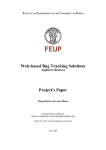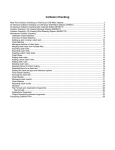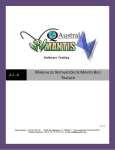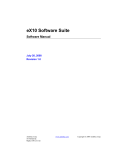Download Open CASCADE Technology Contribution Workflow CONTENTS
Transcript
© OPEN CASCADE SAS, 2011 DOC REF: 339 OCCT CONTRIBUTION WORKFLOW PROJECT: OCCT DEVELOPMENT Open CASCADE Technology Contribution Workflow CONTENTS 1. INTRODUCTION ___________________________________________________________ 2 1.1. Tracker system ________________________________________________________________ 2 1.2. Access Levels_________________________________________________________________ 2 2. TYPICAL WORKFLOW FOR AN ISSUE ___________________________________________ 3 2.1. General scheme _______________________________________________________________ 3 2.2. Issue registration ______________________________________________________________ 4 2.3. Assigning the issue_____________________________________________________________ 4 2.4. Resolving the issue ____________________________________________________________ 5 2.5. Code review __________________________________________________________________ 5 2.6. Testing ______________________________________________________________________ 5 2.7. Integration of a solution _________________________________________________________ 5 2.8. Closing a bug _________________________________________________________________ 6 2.9. Reopening a bug ______________________________________________________________ 6 3. APPENDIX ______________________________________________________________ 7 3.1. Issue attributes ________________________________________________________________ 3.1.1. Severity __________________________________________________________________ 3.1.2. Statuses of issues __________________________________________________________ 3.1.3. Resolutions _______________________________________________________________ 7 7 7 8 3.2. Update and evolution of documentation_____________________________________________ 3.2.1. Maintenance of CDL files_____________________________________________________ 3.2.2. Maintenance of the User’s Reference Documentation ______________________________ 3.2.3. Preparation of the Release Documentation_______________________________________ 8 8 9 9 OPEN CASCADE SAS Page 1 / 9 © OPEN CASCADE SAS, 2011 DOC REF: 339 OCCT CONTRIBUTION WORKFLOW PROJECT: OCCT DEVELOPMENT 1. INTRODUCTION The purpose of this document is to describe standard workflow for processing contributions to certified version of OCCT. 1.1. Use of issue tracker system Each contribution should have corresponding issue (bug, or feature, or integration request) registered in the MantisBT issue tracker system accessible by URL http://tracker.dev.opencascade.org. The issue is processed further according to the described workflow. 1.2. Access Levels Access level defines the permissions of the user to view, register and modify issues in a Mantis bugtracker. The correspondence of access level and user permissions is defined in accordance with the table below. Access level Viewer Reporter Updater Granted to Everyone (anonymous access) Users registered on dev.opencascade.com Users having signed CLA Permissions Can set statuses View issues only - View and report issues New, Resolved View, report, modify, and handle issues New, Resolved, Reviewed According to his access level, the user can participate in the issue handling process under different roles, as described below. OPEN CASCADE SAS Page 2 / 9 © OPEN CASCADE SAS, 2011 DOC REF: 339 OCCT CONTRIBUTION WORKFLOW PROJECT: OCCT DEVELOPMENT 2. TYPICAL WORKFLOW FOR AN ISSUE 2.1. General scheme A typical life cycle of an issue is represented in the scheme below. See also the description after the scheme. Reporter registers an issue Feedback Reporter provides more info New Bug? Clear? Not clear: more info Maintainer requested checks the description YES, bug Assigned Developer resolves the issue Resolved Reviewer is not satisfied with the fix Reviewer verifies the solution Good? YES, code is good Reviewed + Resolution Tester is not satisfied with the fix Tester verifies the solution Fixed? YES, fixed, no regressions Tested Conflict with other change is detected Conflict? Integrator merges the fix to trunk YES, fixed Integration to the trunk Verified Reviewer is not satisfied with the fix Reporter can re-check the fix OK? YES, fixed Delivery of the release Closed OPEN CASCADE SAS Page 3 / 9 © OPEN CASCADE SAS, 2011 DOC REF: 339 OCCT CONTRIBUTION WORKFLOW PROJECT: OCCT DEVELOPMENT 2.2. Issue registration An issue is registered in Mantis bugtracker by Reporter with definition of the necessary attributes. The definition of the following attributes is obligatory: • Category Indicates component of OCCT to which the issue relates. If in doubt, assign OCCT:Foundation Classes. • Reproducibility • Severity • Priority • Profile Profile option allows defining the platform on which the problem was detected from the list of predefined platforms. If a platform is absent in the list of predefined platforms it is possible to use Or Fill In option to define the platform manually. • o Platform o OS o OS Version Products Version This attribute defines the version of Open CASCADE on which the problem has been detected. • Summary Summary should be a short, one sentence description of the issue. It has a limit of 128 characters. It should be informative and useful for the developers. It is advisable to avoid vague or misleading phrases, such as "it doesn't work" or "it crashed". It is not allowed to mention the issue originator, and namely, the customer in the name of the registered issue. • Description The Description should contain a detailed definition of the nature of the registered issue depending on its type. For a bug it is required to submit a detailed description of the incorrect behavior, including the indication of the cause of the problem (if possible at this stage) or any inputs from the originator. For a feature or integration request it is recommended to describe the proposed feature in details (as possible at that stage), including the changes required for its implementation and the main features of the new functionality. Filling the bug description is obligatory. • Steps To Reproduce In this field it is possible to describe in detail how to reproduce the issue. This field considerably helps to find the cause of the problem, to eliminate it and to create the test case. It is recommended to attach a prototype test case in form of a Tcl script for DRAW, using either existing DRAW commands, or a C++ code which can be organized in DRAW commands, as well as sample shapes or other input data (if applicable), immediately after the issue registration. The additional field Upload File allows attaching the shapes, scripts or modified source files of OCCT. The newly registered issue gets status NEW and is assigned to the developer responsible for the OCCT component indicated in the Category field (Maintainer). 2.3. Assigning the issue The description of the new issue is checked by Maintainer and if it is feasible, he may assign the issue to some Developer. Alternatively, any user with access level updater or higher can assign the issue to himself if he want to provide a solution. The recommended way to handle contributions is that Reporter assigns the issue to himself and provides solution. OPEN CASCADE SAS Page 4 / 9 © OPEN CASCADE SAS, 2011 DOC REF: 339 OCCT CONTRIBUTION WORKFLOW PROJECT: OCCT DEVELOPMENT The Maintainer, Technical Project Manager, or Bugmaster can close or reassign the issue (in FEEDBACK state) to the Reporter after it has been registered, if its description does not contain sufficient details to reproduce the bug or explain the purpose of the new feature. That decision shall be documented in the comments to the issue in the Bugtracker. The assigned issue should have state ASSIGNED. 2.4. Resolving the issue The Developer responsible for the issue assigned to him provides solution as a change on the version of OCCT indicated in the issue attributes, or last development version. The modified sources are submitted in dedicated branch of the version control system, with branch name chosen so as to correspond to the issue ID. Until public version control system is available, external contributors are advised to submit modifications as patch (diff) files. The issue for which solution is provided should be switched to RESOLVED state and assigned to the developer who is expected to make a code review (Reviewer; by default, can be set to Maintainer of the component). 2.5. Code review The Reviewer analyzes the proposed solution for applicability in accordance with OCCT Code reviewing rules and examines all changes in the sources to detect obvious and possible errors, misprints, conformity to coding style. • • If Reviewer detects some problems, he can either: o Fix these issues and provide new solution, reassigning the issue (in RESOLVED state) to the Developer, who then becomes a Reviewer. Possible disagreements should be resolved through discussion, which can be done using contributor’s forum if necessary. o Reassign the issue back to the Developer, providing detailed list of remarks. The issue then gets status ASSIGNED and new solution should be provided. If Reviewer does not detect any problems, he changes status to REVIEWED and assigns it back to the Developer. 2.6. Testing The issues that are in REVIEWED state are subject of certification (non-regression) testing. The results of tests are checked by OCC Tester: • If Tester detects regressions, he changes status to ASSIGNED and reassigns issue to Developer with detailed description of regressions. Developer should produce new solution. • If Tester does not detect regressions. He changes status to TESTED for further integration. 2.7. Integration of a solution Before integration into the trunk of repository Integrator checks the following conditions: • the change has been reviewed; • the change has been tested without regressions (or with regressions treated properly); • the test case has been created for this issue (when applicable), and the change has been rechecked on this test case; • “Additional information and documentation updates” field is filled by developer; • the change does not conflict with other changes integrated previously. OPEN CASCADE SAS Page 5 / 9 © OPEN CASCADE SAS, 2011 DOC REF: 339 OCCT CONTRIBUTION WORKFLOW PROJECT: OCCT DEVELOPMENT If the result of check is successful the Integrator integrates solution into the trunk of repository. The issue status is set then to VERIFIED and is assigned to Reporter so that he could check the fix asintegrated. 2.8. Closing a bug The Bugmaster closes the issue after regular OCCT Release provided that the issue status is VERIFIED and that issue was really solved in that release, by rechecking the corresponding test case. The final issue state is CLOSED. 2.9. Reopening a bug If a regression is detected, the Bugmaster may reopen and reassign the CLOSED issue to the appropriate developer with comprehensive comments about the reason of reopening. The issue then becomes ASSIGNED again. OPEN CASCADE SAS Page 6 / 9 © OPEN CASCADE SAS, 2011 DOC REF: 339 OCCT CONTRIBUTION WORKFLOW PROJECT: OCCT DEVELOPMENT 3. APPENDIX 3.1. Issue attributes 3.1.1. Severity Severity shows at which extent the issue affects the product. The list of used severities is given in the table below in the descending order. Severity Description crash Crash of the application or OS, loss of data Weight for Bug Score 5 Regression corresponding to the previously delivered official version. Impossible operation of a function on any data with no work-around block Missing function previously requested in software requirements specification. 4 Destroyed data. Impossible operation of a function with existing work-around. Incorrect operation of a function on a particular dataset. major Impossible operation of a function after intentional input of incorrect data. 3 Incorrect behavior of a function after intentional input of incorrect data. Incorrect behavior of a function corresponding to the description in software requirements specification. minor 2 Insufficient performance of a function. tweak Ergonomic inconvenience, need of light updates. 1 Inconsistence of program code to the Coding Standard. text Errors in source text (e.g. unnecessary variable declarations, missing comments, grammatical errors in user manuals). 1 trivial Cosmetic bugs. 1 feature Bug fix, new feature, improvement that requires workload estimation and validation. 0 integration request Requested integration of an existing feature into the product. 0 Just a question A question to be processed, without need of any changes in the product. 0 3.1.2. Statuses of issues The bug statuses that can be applied to the issues are listed in the table below. Status New Description New just registered issue. Testing case should be created by Reporter. Feedback The issue requires more information; the original posters should pay attention. Assigned Assigned to a developer. Resolved + one of resolutions Revised OPEN CASCADE SAS The issue has been fixed, and now is waiting for revision. The issue has been revised, and now is waiting for testing. Page 7 / 9 © OPEN CASCADE SAS, 2011 DOC REF: 339 OCCT CONTRIBUTION WORKFLOW PROJECT: OCCT DEVELOPMENT + one of resolutions Tested The fix has been internally tested by the tester with success on the full nonregression database or its part and a test case has been created for this issue. Verified The fix has been integrated into the trunk of corresponding repository Closed The fix has been integrated to a trunk. The corresponding testing case has been executed successfully. The issue is no longer reproduced. 3.1.3. Resolutions Resolution is set when the bug is resolved. “Reopen” resolution is added automatically when the bug is reopened. Resolution Open Fixed Reopened Unable to reproduce Not fixable Duplicate Not a bug No change required Suspended Documentation updated Won’t fix Description The issue is being processed. The issue has been successfully fixed. The bug has been reopened because of insufficient fix or regression. The bug is not reproduced. The bug cannot be fixed because it is a bug of third party software, or because it requires more workload than it can be allowed. The bug for the same issue already exists in the tracker. It is a normal behavior in accordance with the specification of the product The issue didn’t require any change of the product, such as a question issue This resolution is set for Acknowledged status only. It means that the issue is waiting for fix until a special administrative decision is taken (e.g. a budget is not yet set in accordance with the contract) The issue was a normal behavior of the product, but the actions of the user were wrong. The specification and the user manual have been updated to reflect this issue. An administrative/contractual decision has been taken to not fix the bug 3.2. Update and evolution of documentation The documentation on Open CASCADE Technology currently exists in three forms: OCCT Technical Documentation generated automatically with Doxygen tool on the basis of comments in CDL or HXX files. User’s Reference Documentation on OCCT packages and Products supplied in the form of PDF User’s guides OCCT Release Documentation supplied in the form of Release Notes with each release. It is strictly required to properly report the improvements and changes introduced in OCCT in all three forms of Documentation. 3.2.1. Maintenance of CDL files Every developer providing a contribution to the source code of OCC should make a relevant change in the corresponding header file, including CDL. Making the appropriate comments is mandatory in the following cases: Development of a new package/class/method/enumeration; Modification of an existing package/class/method/enumeration that changes its behavior; Modification / new development impacts at other packages/classes/methods/enumerations, the documentation of which should be modified correspondingly. The only case when the comments may be not required is introducing a modification that does not change the existing behavior in any noticeable way or brings the behavior in accordance with the existing description. CDL description must be in good English, containing as much relevant information and as clear as possible. If the developer is unable to properly formulate his ideas in English or suspects that his OPEN CASCADE SAS Page 8 / 9 © OPEN CASCADE SAS, 2011 DOC REF: 339 OCCT CONTRIBUTION WORKFLOW PROJECT: OCCT DEVELOPMENT description can be misunderstood, he should address to the Documentation Engineer for language assistance. Such action is completely subject to the discretion of the developer; however, the Documentation Engineer can require that the developer should provide a relevant technical documentation and reopen a bug until all documentation satisfies the requirements above. 3.2.2. Maintenance of the User’s Reference Documentation The User’s Reference Documentation is distributed among a number of User’s Guides, each describing a certain module of OCCT. The User's Guides do not cover the entire functionality of OCCT; however, they describe most widely used and important packages. In most aspects the User's Guides present the information that is already contained in CDL descriptions for methods, classes, etc., only with different formatting, Thus, it is required that any developer who implements a new or modifies an existing package/class/method/enumeration and adds a description of new development or changes in the corresponding CDL file should also check if this class package/class/method/enumeration or the package/class to which the added class/method belongs is already described in the documentation and update the User’s Reference Documentation correspondingly. 3.2.3. Preparation of the Release Documentation Before changing the bug Status to RESOLVED, the developer should provide a description of the implemented work using the “Additional information and documentation updates” field of Mantis bugtracker. This description is used for the Release Documentation and has the following purposes: to inform the OCCT users about the main features and improvements implemented in the platform in the release; to give a complete and useable list of changes introduced into the OCCT since the latest version. The changes should be described from the user’s viewpoint so that the text could be comprehensible even for beginners having a very vague idea about OCCT. If the developer is unable to properly formulate his ideas in English or suspects that his description can be misunderstood, he should address to the Documentation Engineer for language assistance. Such action is completely subject to the discretion of the developer; however, the Documentation Engineer can require that the developer should provide a relevant technical documentation and reopen a bug until all documentation satisfies the requirements. Note: It is required to single out the changes in the OCCT behavior as compared to the previous versions and especially the changes to be considered when porting from the previous version of OCCT. For example: If global macros XXX() was used in the code of your application, revise it for direct use of the argument stream object. or: You might need to revise the code related to text display in 3d viewer to take into account new approach of using system fonts via XXX library. The Documentation Engineer is responsible for preparation of the version Release Notes and update of the User’s Guides. If the Documentation Engineer considers that the description currently provided by the Developer is somehow inadequate or unsatisfactory he can demand the Developer to rewrite the documentation with the Documentation Engineer’s assistance. The contents and recommended structure of the message depend on the nature of the bug. All bugs can be roughly subdivided in two categories: large-scale or punctual development. OPEN CASCADE SAS Page 9 / 9

















